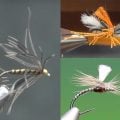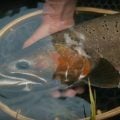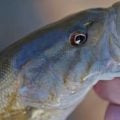Fly Tying: How to Tie an Isonychia Nymph
Producer: Tim Flagler
Fly Tying: Isonychia Nymph
This stylish-looking Isonychia Nymph has been working very well for me as of late, both dead-drifted and swung more like a wet fly. Although I’ve taken a few liberties with materials, it’s for all intents and purposes a pattern developed by Preston Jennings many years ago. He apparently designed it primarily for use on the Esopus Creek in the Catskills.
For a hook, I’m going modern and using a Fulling Mill size 12 nymph hook with a black nickel finish. Get the hook firmly secured in the jaws of your tying vise.
For thread, I’ve loaded a bobbin with a spool of black UTC 70 Denier. Start your thread on the hook shank leaving about an eye-length space behind the eye and take a few wraps rearward before snipping off the tag.
For the tail of the fly, I’m going to use chocolate brown pheasant tail fibers. Pull 6-8 fibers down perpendicular to the stem and strip them free. Cutting off the curlies ensures they won’t interfere with wrapping. Get hold of the fibers in the fingers of your right hand and check to make sure the tips are fairly even. Measure to form a tail a little more than a hook gap in length. Then, use wraps of tying thread to bind the fibers to the top of the hook shank all the way back to the start of the bend. Take thread wraps forward, back to the tie-in point and snip the excess butt ends of the pheasant tail fibers off close.
Brassie-sized gold ultra wire is used to rib and segment the fly, a 10 inch length will make numerous flies. Get hold of one end of the wire and lay it against the near side of the hook at the tie-in point. Start taking thread wraps to bind it first to the near side of the hook, then allow thread torque to carry it over to the far side. This will keep it from disrupting the tail when it’s wrapped. Advance your tying thread forward to about the hook point.
Isonychia-colored Fine & Dry Dubbing is used for the body of the fly. Tease an ample clump free from the packet then pull down on your bobbin to expose about 4 inches of tying thread. Using only small amounts of dubbing at a time, produce a long, fairly thin noodle on your tying thread. Long and thin will definitely work better than short and thick. Start taking wraps with the noodle so the dubbing begins right at the base of the tail, then continue taking touching wraps forward to build up a lightly tapered body on the fly. Make sure to leave that eye-length space behind the eye free.
Get hold of the gold wire and start making open spiral wraps with it. Notice how it doesn’t contact or disrupt the tail. Try to keep the open spiral wraps as even as possible as you work your way up the hook shank, 7 or 8 turns usually looks pretty good. Anchor the wire at a point about 2 eye-lengths behind the back edge of the hook eye. Then helicopter to break it off close. Use your tying thread to compress the front edge of the dubbing and to build a gently sloping ramp from the dubbed body down to the bare hook shank.
Peacock herl is used for the thorax of the fly. Pull 2 or 3 strands free from the packet by their tips then snip an inch or so of those brittle tips off square. Lay the snipped ends against the near side of the hook and take thread wraps to secure them. Leaving your thread at the front edge of the body, begin making wraps with both herls forward toward the eye. Once again, keep that space open behind the eye as you take thread wraps to secure the peacock herl. When it’s bound down, snip the excess butt ends off close.
I’m going to use a somewhat geographically-appropriate hackle for this fly and select a single feather from the saddle as opposed to the cape, they came together. I just love the mix of colors on this barred-ginger variant. Although not essential, I do like to measure the hackle to ensure it roughly matches the hook size. Snip the butt end of the feather off right where the stem begins to thin then pull a few fibers down and trim them to form a small triangular tie-in anchor. Lay the anchor against the near side of the hook and take firm thread wraps to secure it all the way to the back edge of the hook eye. Make sure it’s bound down really well. Use your regular or plunger-style hackle pliers to get hold of the feather’s tip. Pull the stem down between the fingers of your left hand as you preen and fold the fibers rearward. Start taking wraps with the folded hackle, coaxing the fibers back as you go, 2 or 3 turns is usually plenty. Use your tying thread to anchor the feather’s tip doing your best not to trap hackle fibers in the process. Once the stem is secure, snip the excess off close. You can then preen all the fibers rearward, take a few thread wraps to hold them back and build a short little head on the fly.
Pick up your whip finish tool and use it to do a 5 or 6 turn whip finish then seat the knot well and snip or cut your tying thread free. A drop of head cement here, Sally Hansen Hard as Nails, applied to the thread wraps will ensure they won’t come unraveled.
I don’t really know what it is about these old patterns that I like so much, but they just give me that warm and fuzzy feeling whenever I tie one on and fish with it.
Fly Tying: How to Tie a Western Coachman
Fly Tying: How to Tie the Ant Acid











